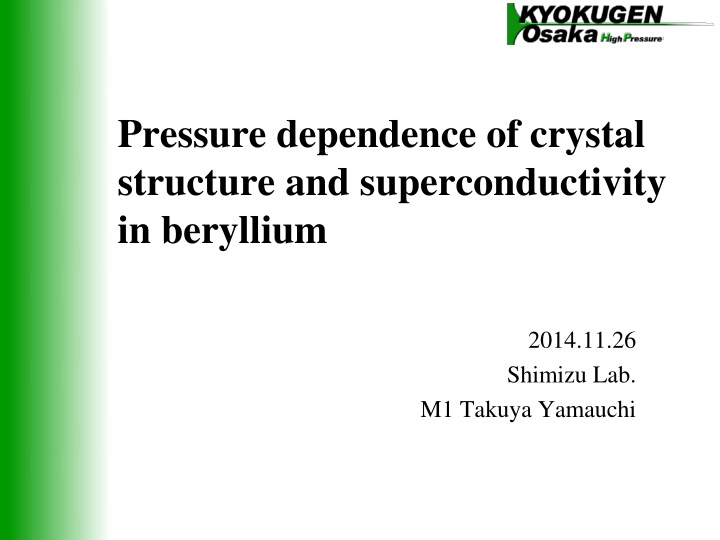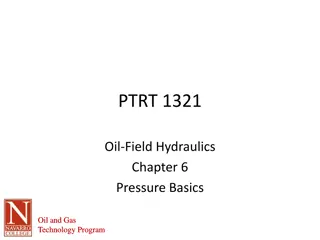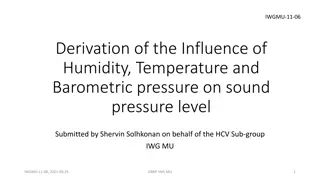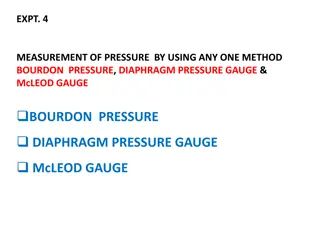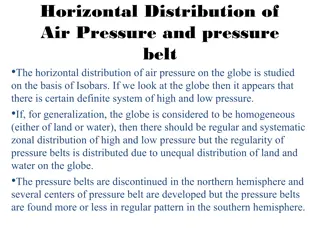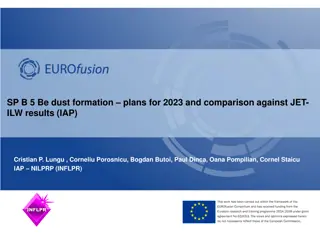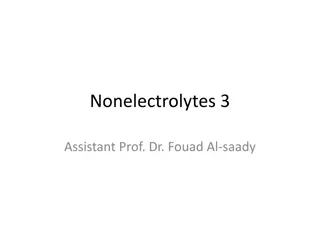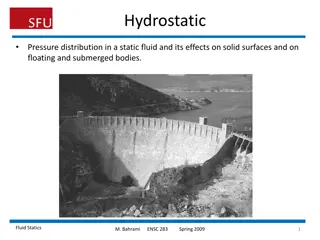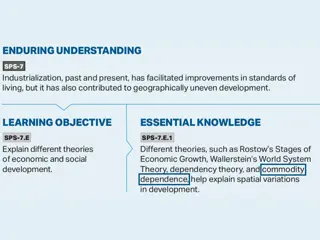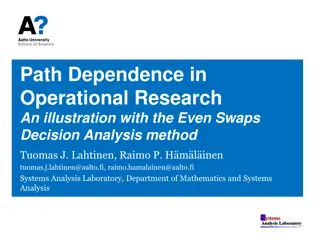Pressure Dependence of Crystal Structure in Beryllium
Pressure dependence of crystal structure and superconductivity in beryllium through a detailed study on how the critical temperature of superconductivity is affected by structural changes at varying pressures. Experimentation, measurements, results, and discussions shed light on the intricate relationship between pressure, crystal structure, and superconductivity in light elements like beryllium.
Download Presentation

Please find below an Image/Link to download the presentation.
The content on the website is provided AS IS for your information and personal use only. It may not be sold, licensed, or shared on other websites without obtaining consent from the author.If you encounter any issues during the download, it is possible that the publisher has removed the file from their server.
You are allowed to download the files provided on this website for personal or commercial use, subject to the condition that they are used lawfully. All files are the property of their respective owners.
The content on the website is provided AS IS for your information and personal use only. It may not be sold, licensed, or shared on other websites without obtaining consent from the author.
E N D
Presentation Transcript
Pressure dependence of crystal structure and superconductivity in beryllium 2014.11.26 Shimizu Lab. M1 Takuya Yamauchi
Contents Introduction Superconductivity of light elements Enhancement of Tc Structure Previous work Motivation Experiment Measurement of X-ray diffraction. Measurement of electrical resistance. Result Discussion Summary
Superconductivity of light elements Introduction The superconducting critical temperature(Tc) of beryllium is very lower than other light elements. Beryllium Tc=24mK My target Ref. HP@SPring8(2011)
In case of Calcium and Lithium Lithium Calcium 16 K 29 K 0.4 mK Ref. M. Sakata., et al., PRB 83, 220512 (2011). Ref. T. Matsuoka, et al., j, phys, 121, 052003 (2008). Calcium s Tcachieves 29 K, which is the highest Tc in elements. Tcof Li < 0.4 mK at 1 atm, but under high pressure, Tc~16 K.
Enhancement of Tc Introduction In BCS theory Tc= 1.14 Dexp[-1/NV] D: Debye temperature N: Density of state at the Fermi surface V: Interaction between electron and lattice vibration In light elements Intensity of attraction between the electron does not change that causes increase of d. d: Debye frequency Tc D,N,V However Tc(24 mK) is too low. D cf. Li 344 K Ca 230 K very high Approaching to N,V Applying pressure D of Be is 1440 K.
Structure of beryllium Introduction Beryllium has small c/a ratio. 1.568 (Its ideal value of hcp is 1.633 ) heat pressure bcc(1530 Melting point: 1551 K 1560 K) 1530 K) hcp( hcp structure is stable at ambient temperature and pressure. bcc structure would be appeared at high temperature and prssure. Ref. D. A. Young, Phase Diagrams of the Elements (University of California, 1991), P. 79.c
Previous work Introduction 4 No pressure medium Beryllium Pressure dependence of Tc and c/a[2] 3 The Tc of beryllium has enhanced in a pressure range, where a decrease its c/a ratio was observed. Tc (K) 2 1 24 mK 0 T= LT 1.57 c/a 1.55 1.53 0 20 40 60 80 P (GPa) Ref. K.Kubota (2013)
Motivation Experiment @Spring-8 BL10XU 1. I ll confirm whether the structure changes. measure the c/a ratio and volume by using powder X-ray diffraction. X-ray Diamond anvil cell Imaging plate ( ) 40.00 2. resistance of beryllium to see the its drop caused by superconductivity. I ll measure the electrical Beryllium 30 GPa 39.95 R (m ) 39.90 0.1 mA 1.0 mA The decrease of electrical resistance rate is only 0.13%. 39.85 0 2 4 6 8 10 T (K) Ref. K.Kubota (2013)
Settings Experiment For the accurate measurement of c/a ratio. : No pressure Medium NM Sample: Be (99.9 %) Diamond anvil: 300 m Gasket: Re Pressure marker: Ruby Pressure medium: none, He(gas) : with pressure medium He He Diamond anvil once twice NM He Gasket 300 m Pressure maker Beryllium Ruby sample
X-ray diffraction pattern Experiment =0.414 =0.413 He NM 101 110 102 101 102 110 Fe 100 002 49.3 GPa 100 002 50.1 GPa 39.5 GPa 31.2 GPa Fe 39.5 GPa 30.9 GPa Intensity Intensity 21.1 GPa 20.7 GPa 11.4 GPa 13.0 GPa 3.8 GPa 5.3 GPa 10 12 14 16 18 20 22 24 10.0 12.5 15.0 17.5 20.0 22.5 2 (degrees) 2 (degrees) Beryllium has characteristic five peaks. The peak 002 disappeared with applying pressure. Beryllium s atomic number is 4, so it has very few electrons. Affection of orientation is weak.
Orientation Experiment My sample beryllium is polycrystal. NM c c pressure a a Peak corresponding to c-axis is weakened. : Direction of the crystal
Calculation of c/a ratio Experiment 101 110 He 102 Bragg s condition 002 =0.414 const. 2dsin = 100 ? d= ????? Miller index Low pressure High pressure (100) (002) (101) (102) (110) The value of c/a ratio can have more error at high pressure. Calculate with the cellcalc.
c/a ratio ResultDiscussion c/a vs P 1.650 hcp's ideal value: 1.633 1.625 No pressure medium The c/a ratio decrease at specific pressure. He First-principles He_1 He_2 1.600 c/a 1.575 with pressure medium He The c/a ratio increase monotonically with increasing pressure. 1.550 NM, 13-56K[1] NM, room temp. [1] NM_1 1.525 NM 1.500 0 10 20 30 40 50 60 P ( GPa) [1] K.Kubota (2013)
Setting Experiment For the measurement of electrical resistance. Sample: Be (99.9 %) Diamond anvil: 300 m Gasket: SUS310S Insulator layer: c-BN with epoxy Electrodes: Pt Pressure medium: none Pressure marker: Ruby NM 300 m Electrodes Pressure maker ruby Insulator layer sample Gasket 31.2 GPa 11.2 GPa
Electrical resistance ResultDiscussion R vs T NM 16 9.5 14 Low temp. 12 9.0 10 R( m 8.5 Tmin=75 mK 8 R(m ) Beryllium 31 GPa 27 GPa 23 GPa 8.0 6 Be 31GPa 27GPa 23GPa 7.5 4 2 7.0 0 6.5 0 30 60 90 120150180210240270300 T( K) 0 1 2 3 4 5 T(K)
Problems ResultDiscussion Possibility Pressure effect. Impurities(Fe) Setting. Oxidization of sample. Error of data. 40.00 Beryllium 30 GPa Be 31GPa 8.80 39.95 Tmin=75 mK I=0.1 mA Error: 0.05 m R (m ) 8.75 Its decrease is only 0.05 m R( m ) 39.90 0.1 mA 1.0 mA 8.70 8.65 39.85 0 2 4 6 8 10 0 1 2 3 4 5 T (K) T( K)
Summary I confirmed the changes of c/a ratio in beryllium. The changes have caused by presence or absence of pressure medium. The decrease of electrical resistance caused by superconductivity couldn t be seen. THE END.
